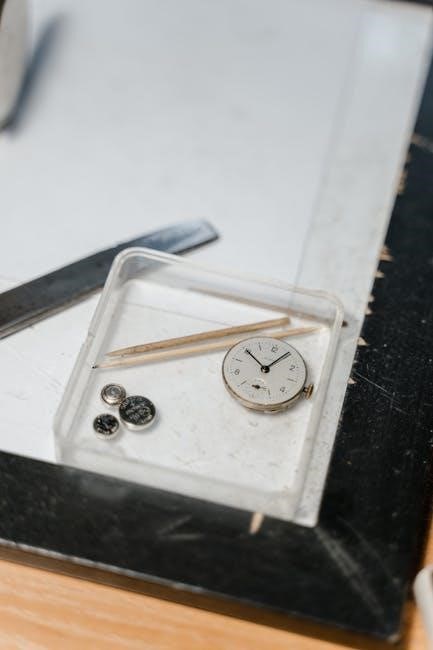Welcome to the Craftsman Miter Saw Manual, your comprehensive guide to understanding and operating your tool safely and effectively. This manual provides essential information on setup, operation, and maintenance to ensure optimal performance and longevity of your miter saw.
1.1 Importance of Reading the Manual
Reading the Craftsman Miter Saw Manual is essential for safe and effective operation. It provides critical safety precautions, setup instructions, and maintenance tips to ensure optimal performance. Understanding the manual helps you avoid accidents, prevent damage to the tool, and maximize its potential. It also guides you through troubleshooting common issues and explains proper usage of features like miter and bevel adjustments. Taking the time to review the manual thoroughly will help you master your miter saw and achieve professional-grade results in your projects. Always refer to the manual before operating the saw for the first time.
1.2 Overview of the Craftsman Miter Saw
The Craftsman Miter Saw is a versatile power tool designed for precise angled cuts in woodworking and construction projects. Available in models like the 21239 and 315.212120, it offers sliding and compound cutting capabilities, enabling both miter and bevel adjustments. The saw features positive stops for common angles and a durable, double-insulated design for safe operation. Its robust construction and user-friendly controls make it suitable for professionals and DIY enthusiasts alike. This tool is ideal for tasks requiring accuracy, such as installing trim, crown molding, and framing. Craftsman’s reputation for quality ensures reliability and performance in every cut.
Safety Precautions and Warnings
Always read and follow all safety rules and warnings in this manual. Keep loose clothing tied back, avoid unsafe modifications, and ensure the saw is stable before use. Contact Sears at 1-800-932-3188 for assistance.
2.1 General Safety Rules
Always wear safety glasses and keep loose clothing tied back. Ensure the work area is clean and well-lit. Avoid wearing jewelry that could get caught in moving parts. Never operate the saw while tired or under the influence of drugs or alcohol. Keep children and pets away from the work area. Use proper lifting techniques to avoid injury. Familiarize yourself with all controls before starting. Never modify the saw or use it for purposes other than intended. Follow all instructions in this manual and contact Sears at 1-800-932-3188 for assistance.
2.2 Specific Safety Instructions for Miter Saw Operation
Always ensure the miter saw is securely fastened to a sturdy bench or stand to prevent movement during operation. Use proper hold-down devices or clamps to secure materials firmly. Never cross your arms or position your body in the path of the saw blade. Keep hands away from the cutting area and use a push stick for small or narrow workpieces. Maintain a firm grip on materials to avoid kickback. Ensure the blade is completely stopped before adjusting settings or retrieving cutoffs. Regularly inspect the blade for damage and replace it if necessary to prevent accidents. Follow all manufacturer guidelines for blade selection and usage.
2.3 Warning Labels and Symbols
Warning labels and symbols on your Craftsman miter saw are critical for safe operation. These labels highlight potential hazards, such as rotating blades, electrical components, and sharp edges. Always read and understand the meanings of these symbols before using the saw. Common symbols include warnings for eye protection, proper handling, and the dangers of loose clothing or long hair near moving parts. Ensure all labels remain visible and intact; if damaged, refer to the manual for replacements. Ignoring these warnings can result in serious injury or equipment damage. Always follow the precautions indicated by these labels to ensure safe and effective operation.
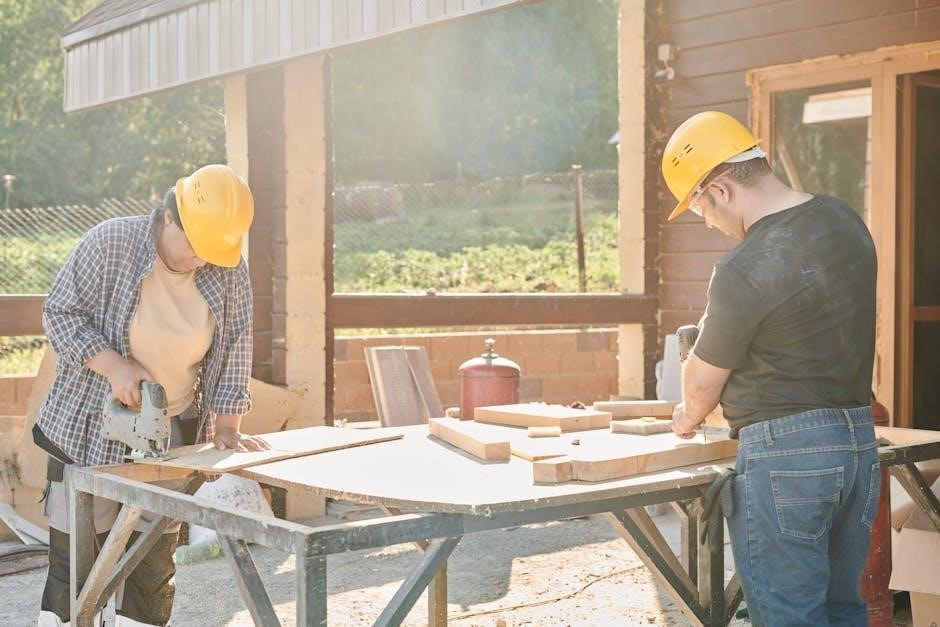
Understanding the Craftsman Miter Saw
The Craftsman miter saw is designed for precise cuts with adjustable miter and bevel settings, ideal for crown molding and trim work. Models like 21239 and 315.212120 feature sliding compound capabilities for wider cuts, with positive stops at common angles like 0°, 15°, 22.5°, 31.6°, and 45°, ensuring accuracy and efficiency.
3.1 Key Features and Components
The Craftsman miter saw features a robust design with a sliding compound mechanism, allowing for precise miter and bevel cuts. Key components include a durable miter table, saw arm, and blade guard for safe operation. The double-insulated motor ensures reliable performance, while the large, ergonomic handle provides comfortable control; Models like the 21239 and 315.212120 include positive stops at common angles (0°, 15°, 22.5°, 31.6°, and 45°) for quick adjustments. The saw also comes with a dust bag and a sturdy fence system for accurate cuts, making it ideal for crown molding, trim work, and other woodworking projects.
3.2 Model-Specific Details (e.g., 21239, 315.212120)
Model 21239 is a 12-inch sliding compound miter saw, designed for precision cuts with its robust sliding mechanism. The 315.212120 model offers a 12-inch compound miter saw with double insulation for enhanced safety and durability. Both models feature positive miter stops at common angles (0°, 15°, 22.5°, 31.6°, and 45°) for quick adjustments. The 21239 includes a dust bag and large ergonomic handle for comfort, while the 315.212120 focuses on smooth operation with its professional-grade fence system. These models cater to both professionals and serious DIYers, ensuring accurate and efficient cutting for various woodworking projects.
3.3 Miter and Bevel Setting Capabilities
The Craftsman miter saw offers precise angle adjustments for both miter and bevel settings, enabling versatile cuts for various projects. The miter table locks at common angles like 0°, 15°, 22.5°, 31.6°, and 45°, while the bevel function allows for adjustments up to 45° in both left and right directions. Dual bevel models provide additional flexibility for complex cuts. For accuracy, always tighten the miter lock handle and bevel locking mechanism securely after adjustments. These features make the saw ideal for crown molding, trim work, and other applications requiring precise angular cuts. Regular calibration ensures consistent performance and accuracy over time.

Assembly and Installation
Begin by unpacking and inventorying all parts, ensuring nothing is missing. Follow the manual to set up the miter saw, then secure it firmly to a bench or stand for stability.
4.1 Unpacking and Inventory of Parts
Begin by carefully unpacking the Craftsman miter saw and all included accessories. Check the contents against the packing list in the manual to ensure everything is accounted for. Typically, the package includes the saw unit, fence, dust bag, and hardware. Inspect each component for damage during shipping. If any parts are missing or damaged, contact Craftsman customer support immediately. Organize the parts neatly to avoid misplacement. This step ensures a smooth assembly process and helps prevent delays. Proper inventory ensures all necessary tools are available before proceeding with setup.
4.2 Setting Up the Miter Saw
Place the miter saw on a stable, flat surface, ensuring it is level and secure. Check for any shipping damage and verify all parts are included. Align the fence with the blade to ensure accurate cuts. Position the saw on a sturdy bench or stand if desired, but ensure it remains stable. Connect the saw to a properly grounded power source, adhering to the voltage specifications in the manual. Double-check all moving parts for proper alignment and function. Perform a final inspection to ensure all components are securely fastened before operation.
4.3 Securing the Saw to a Bench or Stand
To ensure stability and safety, secure the miter saw to a sturdy bench or stand. Position the saw on the bench, ensuring it is level and aligned properly. Use the mounting holes on the saw’s base to attach it with bolts that fit the bench’s thickness. Tighten the bolts firmly but avoid overtightening to prevent damage. Ensure the saw remains stable during operation by checking for any movement. For added stability, consider using clamps or additional support brackets. Finally, verify that the saw is level and plumb to maintain accuracy in your cuts.
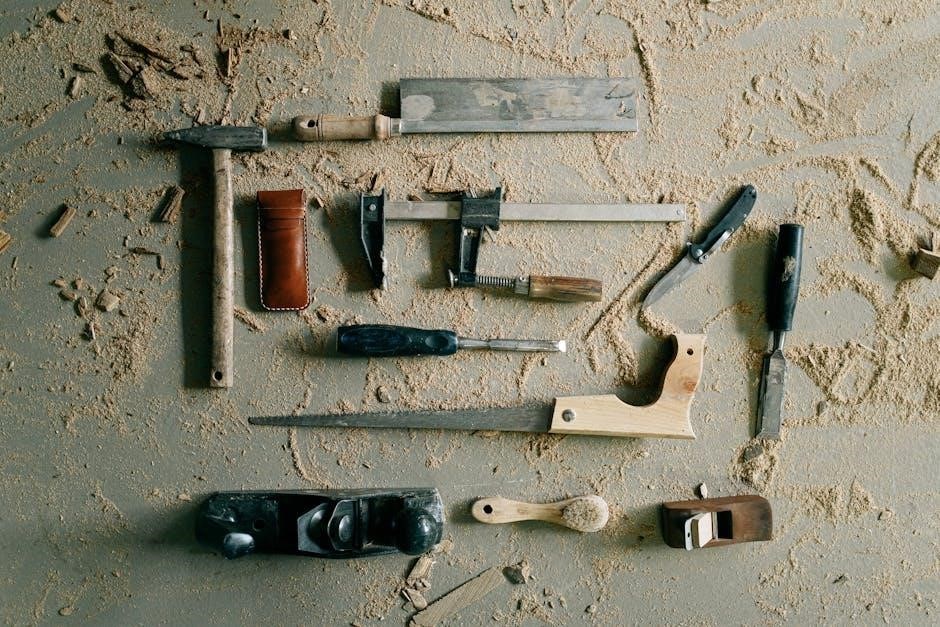
Operating the Miter Saw
Always perform pre-operation checks, align the blade with the material, and use the miter lock handle to secure the table. Control the saw arm smoothly for precise cuts.
5.1 Pre-Operation Checks
Before operating the Craftsman miter saw, ensure all safety precautions are met. Verify the saw is stable and securely fastened to a bench. Check for loose parts, proper blade installation, and ensure the miter table and arm are locked. Inspect the blade for damage or wear; replace if necessary. Confirm power cords are undamaged and keep work area clear of debris. Wear safety goggles and ensure no loose clothing could obstruct operation. Familiarize yourself with controls and ensure all warning labels are visible and understood. Always refer to the manual for specific guidelines to maintain safety and accuracy during use.
5.2 Locking the Miter Table and Saw Arm
Locking the miter table and saw arm ensures precise cuts and prevents movement during operation. To lock the miter table, tighten the miter lock handle firmly. For the saw arm, locate the bevel lock and secure it by tightening the bevel lock handle. Ensure both locks are engaged for stability. Double-check that the miter table is at the desired angle and the saw arm is fully lowered before locking. Proper locking prevents accidental movement, enhancing accuracy and safety. Always verify the locks are secure before starting your cut to avoid vibrations or misalignments during operation.
5.3 Making Accurate Cuts: Miter and Bevel Adjustments
Accurate cuts require precise miter and bevel adjustments. The miter table allows for angle adjustments, with common stops at 0°, 15°, 22.5°, 31.6°, and 45°; To set the miter angle, rotate the table to the desired position and tighten the miter lock handle. For bevel adjustments, tilt the saw arm to the desired angle using the bevel control and secure it with the bevel lock handle. Ensure both adjustments are firmly locked before cutting to maintain accuracy. Proper alignment and locking of these settings are crucial for achieving clean, precise cuts in your projects.
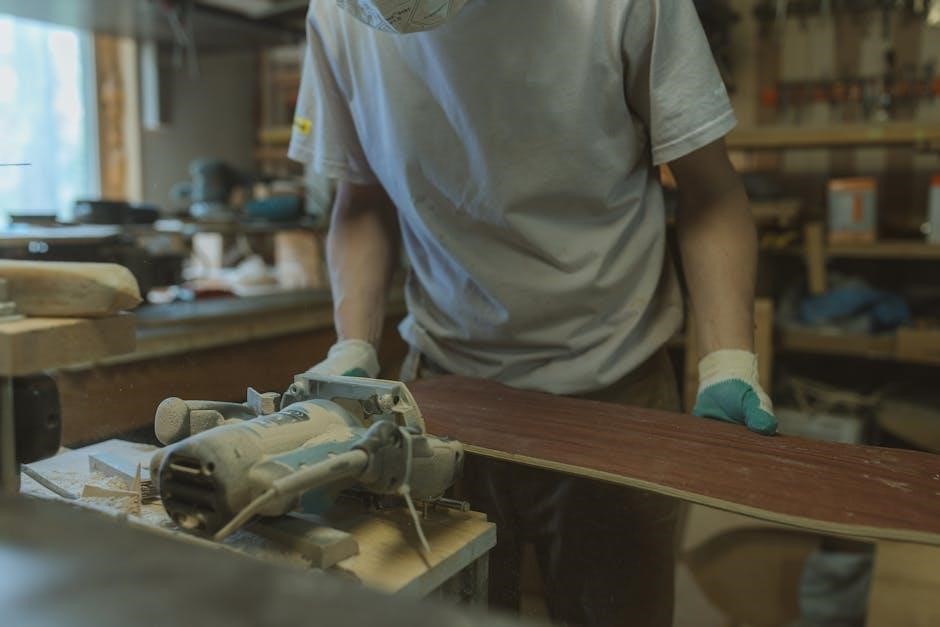
Maintenance and Care
Regular maintenance ensures optimal performance. Clean the saw, lubricate moving parts, and inspect the blade. Proper care extends the tool’s lifespan and maintains accuracy in cuts.
6.1 Cleaning the Miter Saw
Cleaning your Craftsman Miter Saw is essential for maintaining its performance and accuracy. Start by turning off and unplugging the saw to ensure safety. Use a soft brush or cloth to remove dust and debris from the blade, miter table, and saw arm. Avoid using harsh chemicals or abrasive materials that could damage the finish. Wipe down the handle and controls with a damp cloth. Regular cleaning prevents sawdust buildup and ensures smooth operation. Always dry the saw thoroughly after cleaning to prevent rust or corrosion. Proper maintenance will extend the lifespan of your tool and keep it functioning at its best.
6.2 Lubricating Moving Parts
Lubricating the moving parts of your Craftsman Miter Saw ensures smooth operation and reduces wear. Apply a small amount of silicone-based lubricant to the miter table hinges, saw arm pivot points, and bevel adjustment mechanisms. Avoid over-lubrication, as it may attract dust and debris. Use a clean cloth to wipe away excess lubricant. Regular lubrication prevents corrosion and maintains precise adjustments. For optimal performance, lubricate after cleaning or every 50 hours of use. Refer to the manual for specific lubricant recommendations to keep your tool running efficiently and extend its lifespan. Proper lubrication is key to maintaining accuracy and reliability.
6.3 Blade Maintenance and Replacement
Regular blade maintenance ensures precise cuts and extends the life of your Craftsman Miter Saw. Inspect the blade for wear, damage, or debris. Clean the blade with a wire brush or solvent to remove residue. For replacement, unplug the saw and use the provided wrench to loosen the arbor nut. Remove the old blade and install the new one, ensuring it is securely tightened. Refer to the manual for torque specifications. Always use high-quality, compatible blades for optimal performance. Proper blade care enhances accuracy and safety, keeping your miter saw operating at its best for years to come.
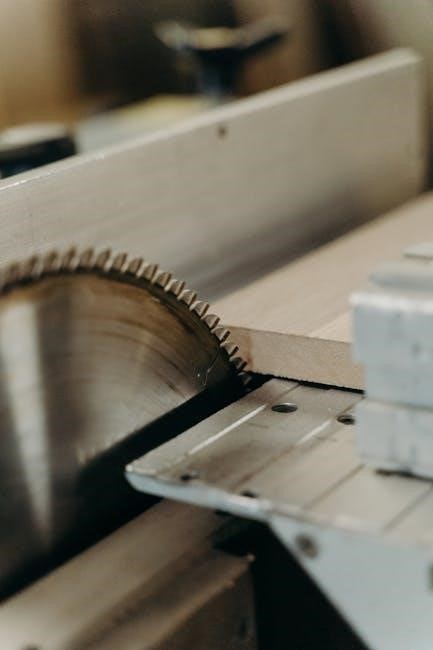
Troubleshooting Common Issues
Troubleshoot common problems like blade wear, misalignment, or vibration by checking the manual for solutions. Address issues promptly to maintain accuracy and ensure safe operation.
7.1 Common Problems and Solutions
Addressing common issues is crucial for optimal performance. Blade wear can cause inaccurate cuts, while misalignment leads to uneven results. Vibration may indicate improper setup. To resolve these, refer to the manual for calibration steps, blade replacement guides, and stability checks. Regular maintenance, such as lubricating moving parts, also prevents operational issues. Always ensure the saw is securely fastened to a bench to minimize vibration and ensure accuracy. Consulting the troubleshooting section helps in quickly identifying and resolving problems, ensuring your miter saw operates efficiently and safely. Immediate attention to these issues prevents further complications and extends tool longevity.
7.2 Adjusting the Miter Saw for Accuracy
Accuracy is key for precise cuts. Start by ensuring the fence is parallel to the blade and the miter table is calibrated to 0 degrees. Check the detent stops for proper alignment and adjust if necessary. Use a combination square to verify the blade’s alignment with the fence. If cuts are uneven, tighten the saw arm and ensure all locking knobs are secure. Test accuracy with a scrap piece and refer to the manual for detailed calibration steps. Regular adjustments ensure consistent results and extend the tool’s lifespan. Always follow safety guidelines during adjustments to avoid accidents.
7.3 Dealing with Vibration or Noise
Excessive vibration or noise can affect performance and safety. Ensure the miter saw is securely fastened to a stable workbench to minimize movement. Check for loose screws or bolts, especially around the saw arm and miter table. Worn or damaged blades can cause vibration; replace them with high-quality, compatible blades. Proper blade installation and alignment are critical. If noise persists, inspect the motor and belts for wear. Lubricate moving parts as recommended in the manual. Always follow safety guidelines when troubleshooting to prevent accidents. Regular maintenance helps reduce vibration and ensures smooth operation;

Warranty and Customer Support
Craftsman offers comprehensive customer support and warranty services. Contact their Help Line at 1-800-932-3188 or visit www;sears.com for resources, manuals, and troubleshooting assistance.
8.1 Understanding the Warranty
The Craftsman miter saw is backed by a comprehensive warranty program. Typically, Craftsman tools, including miter saws, come with a 5-year limited warranty covering defects in materials and workmanship. This warranty applies to original purchasers and is non-transferable. For specific details, refer to the warranty section in your manual or visit the Sears website. The warranty does not cover normal wear, misuse, or alterations. Keep your proof of purchase and contact customer service for any warranty-related inquiries or claims.
8.2 Contacting Craftsman Customer Service
For assistance with your Craftsman miter saw, contact the dedicated customer service team. Call the Craftsman Help Line at 1-800-932-3188 for technical support, warranty inquiries, or general questions. Representatives are available to address concerns and provide guidance. Visit the official Sears website at www.sears.com/craftsman for additional resources, including online manuals and troubleshooting guides. Ensure you have your model number and a detailed description of your issue ready when calling. This will help expedite your support experience. Online chat and email options may also be available for convenience.
8.3 Online Resources and Manuals
Access a wealth of resources and manuals for your Craftsman miter saw online. Visit the official Sears website at www.sears.com/craftsman to download operator manuals, parts diagrams, and troubleshooting guides. Model-specific manuals, such as those for the Craftsman 21239 and 315.212120, are available for free. Additionally, websites like www.manualslib.com/craftsman offer comprehensive libraries of user manuals and instructional materials. These resources ensure you have everything needed to operate, maintain, and repair your miter saw effectively. Utilize these tools to maximize your tool’s performance and extend its lifespan.
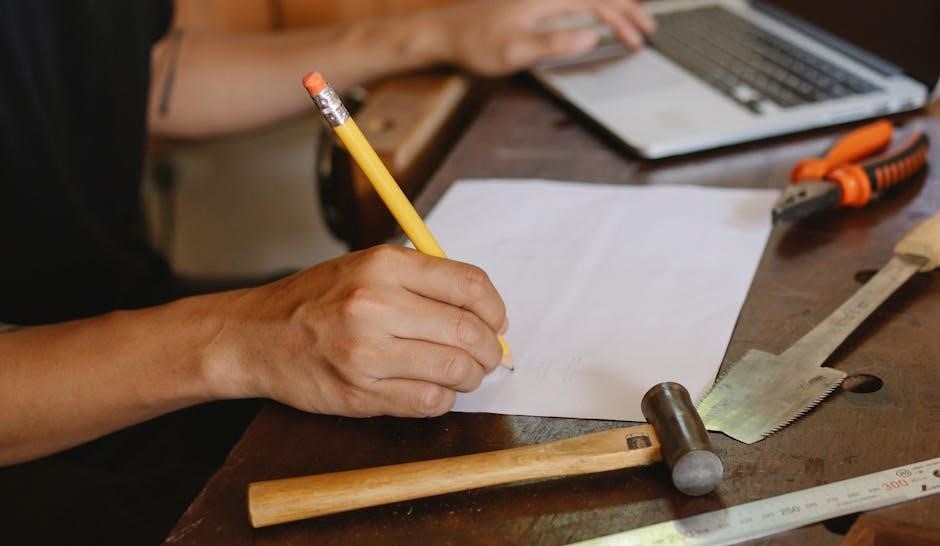
Accessories and Attachments
Enhance your miter saw’s functionality with genuine Craftsman accessories, including high-quality blades, stands, and laser guides. These additions optimize performance and precision for various cutting tasks.
9.1 Recommended Blades and Accessories
For optimal performance, use genuine Craftsman blades and accessories. Choose from a variety of high-quality saw blades, including standard, combination, and specialty options. A sturdy miter saw stand or workbench enhances stability, while laser guides improve cutting accuracy. Dust bags and collection systems help maintain a clean workspace. Additional accessories like extension wings and clamps can expand your saw’s versatility. Always refer to your model-specific manual for compatibility, such as the 21239 or 315.212120 models. Visit Sears or the Craftsman website for authentic parts and tools to maximize your miter saw’s potential and ensure safety.
9.2 Using Optional Attachments
Optional attachments can enhance your miter saw’s functionality. A laser guide improves cutting accuracy by projecting a precise line. Extension tables or wings expand your workspace, supporting longer materials. Dust collection systems reduce mess, while clamps or hold-downs keep workpieces secure. Stands provide portability and stability, ideal for job sites. When installing attachments, follow the manual’s instructions for your specific model, such as the 21239 or 315.212120. Ensure compatibility to maintain performance and safety. Always use genuine Craftsman accessories for reliability and warranty compliance, and refer to the Sears website for compatible options.
9.3 Upgrading Your Miter Saw
Upgrading your Craftsman miter saw can enhance its performance and versatility. Consider replacing the blade with a high-quality option designed for specific materials like wood or metal. Adding a laser guide improves accuracy, while upgraded stands or extension tables enhance stability and workspace. Ensure all upgrades are compatible with your model, such as the 21239 or 315.212120. Always use genuine Craftsman parts or verified third-party accessories to maintain warranty coverage. For detailed upgrade options, visit the Sears website or refer to the manual. Contact customer support for assistance with compatibility and installation.


